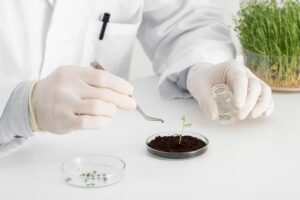Soil health is the foundation of successful agriculture, and understanding the nutrient content of soil is crucial for optimizing crop production. Soil nutrient testing provides valuable insights into the soil’s nutrient levels, helping farmers make informed decisions about fertilization and soil management. In the USA, soil nutrient testers have become an essential tool for farmers, gardeners, and landscapers looking to enhance productivity and promote sustainable practices.
What is Soil Nutrient Testing?
Soil nutrient testing involves analyzing soil samples to determine the concentration of essential nutrients, including nitrogen (N), phosphorus (P), potassium (K), and other macro- and micronutrients. This process helps identify nutrient deficiencies or excesses, enabling tailored fertilization strategies that meet the specific needs of crops.

Source: Freepik
Benefits of Soil Nutrient Testing:
1. Optimized Fertilizer Use:
Soil nutrient testing allows farmers to apply the right amount of fertilizer, avoiding both over-application and under-application. This ensures that crops receive the necessary nutrients without wasting resources or harming the environment.
2. Increased Crop Yields:
By providing crops with the appropriate nutrients, soil nutrient testing can significantly enhance crop yields. Healthy, well-nourished plants are more likely to reach their full potential, resulting in higher productivity.
3. Cost Savings:
Efficient fertilizer use translates to cost savings for farmers. By applying fertilizers based on precise soil nutrient data, farmers can reduce unnecessary expenditures on fertilizers and other soil amendments.
4. Environmental Protection:
Over-application of fertilizers can lead to nutrient runoff, which contaminates water bodies and contributes to issues such as algal blooms and water pollution. Soil nutrient testing promotes environmentally sustainable practices by minimizing nutrient leaching and runoff.
5. Improved Soil Health:
Regular soil testing helps maintain balanced nutrient levels, contributing to long-term soil health. Healthy soils are more resilient to erosion, compaction, and other forms of degradation, supporting sustainable agriculture.
Types of Soil Nutrient Testers:
There are various types of soil nutrient testers available in the USA, ranging from simple handheld devices to sophisticated laboratory-based systems. Here are some common types:
1. Handheld Soil Test Kits:
These kits are portable and easy to use, making them ideal for gardeners and small-scale farmers. They typically test for key nutrients such as nitrogen, phosphorus, and potassium, and provide quick results.
2. Digital Soil Testers:
Digital soil testers use sensors to measure soil nutrient levels and display the results on a digital screen. These devices offer higher accuracy and ease of use compared to traditional test kits.
3. Laboratory Soil Testing:
For comprehensive soil analysis, samples can be sent to a laboratory. Laboratory testing provides detailed information on a wide range of nutrients and soil properties, including pH, organic matter content, and micronutrients. This method is highly accurate and is often used by large-scale farmers and agricultural researchers.
4. Automated Soil Analyzers:
These advanced systems are designed for high-throughput analysis, making them suitable for large farms and research institutions. Automated soil analyzers can process multiple samples simultaneously and provide detailed nutrient profiles.
5. Proximal Soil Sensors:
Utilizing technologies like Electrical Conductivity and Gamma Radiation, proximal soil sensors provide a more in-depth look at soil and how soil properties vary from field to field.
How to Conduct Soil Nutrient Testing:
Conducting soil nutrient testing involves several steps to ensure accurate results:
1. Soil Sampling:
Collecting representative soil samples is the first and most crucial step. Samples should be taken from multiple locations within the field to account for soil variability. A soil auger or probe can be used to collect samples from the top 6-8 inches of soil.
2. Sample Preparation:
Once collected, soil samples should be mixed thoroughly and air-dried. Removing any debris such as roots, stones, and organic matter is essential to obtain a uniform sample.
3. Testing:
Depending on the type of tester being used, the prepared soil sample is then tested for nutrient content. Handheld kits and digital testers provide immediate results, while samples sent to a laboratory will undergo detailed analysis.
4. Interpreting Results:
The results of the soil nutrient test will indicate the levels of various nutrients in the soil. These results can be compared to recommended nutrient levels for the specific crops being grown to determine any deficiencies or excesses.
5. Implementing Recommendations:
Based on the test results, farmers can develop a fertilization plan that addresses nutrient deficiencies and optimizes soil health. This may involve applying specific types and amounts of fertilizers, adjusting pH levels, or incorporating organic matter.
Innovations in Soil Nutrient Testing:
As technology advances, soil nutrient testing is becoming more accessible and accurate. Some emerging trends and innovations include:
1. Remote Sensing and Drones:
Remote sensing technologies and drones are being used to assess soil nutrient levels and variability across large fields. These technologies provide real-time data, allowing for precise and timely interventions.
2. Machine Learning and AI:
Machine learning algorithms and artificial intelligence are being integrated with soil nutrient testing to analyze large datasets and predict nutrient requirements. This can lead to more accurate and efficient soil management practices.
3. Soil Health Monitoring Systems:
Continuous soil health monitoring systems are being developed to provide real-time data on soil nutrient levels, moisture content, and other soil properties. These systems enable proactive soil management and improve long-term soil health.
Conclusion:
Soil nutrient testing is a critical component of modern agriculture in the USA. By providing detailed insights into soil nutrient levels, these tests enable farmers to optimize fertilizer use, enhance crop yields, and promote sustainable practices. With the ongoing advancements in soil testing technologies, the future of soil nutrient management looks promising. As more farmers adopt these tools, the potential for increased productivity and environmental sustainability in American agriculture continues to grow. For more information Visit https://soiloptix.com/
